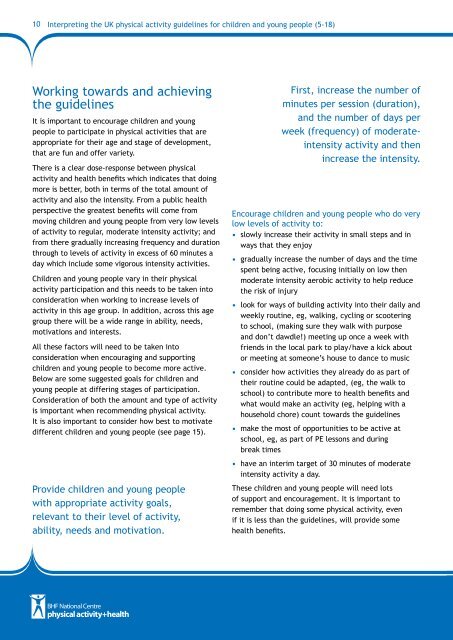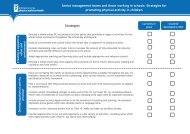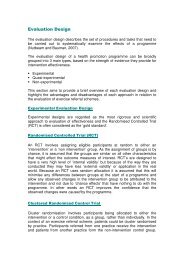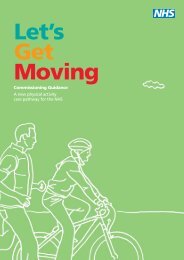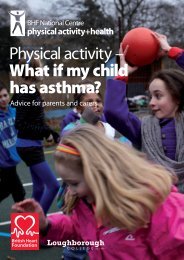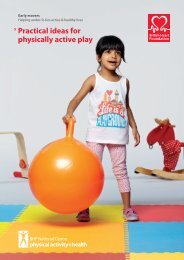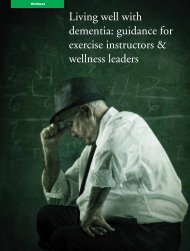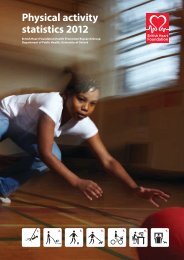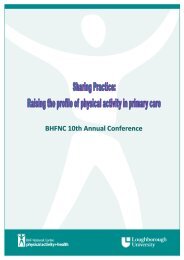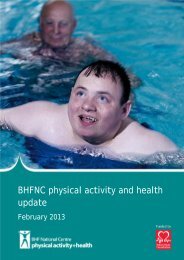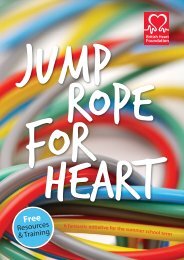Interpreting the UK physical activity guidelines for children and ...
Interpreting the UK physical activity guidelines for children and ...
Interpreting the UK physical activity guidelines for children and ...
You also want an ePaper? Increase the reach of your titles
YUMPU automatically turns print PDFs into web optimized ePapers that Google loves.
10<br />
<strong>Interpreting</strong> <strong>the</strong> <strong>UK</strong> <strong>physical</strong> <strong>activity</strong> <strong>guidelines</strong> <strong>for</strong> <strong>children</strong> <strong>and</strong> young people (5-18)<br />
Working towards <strong>and</strong> achieving<br />
<strong>the</strong> <strong>guidelines</strong><br />
It is important to encourage <strong>children</strong> <strong>and</strong> young<br />
people to participate in <strong>physical</strong> activities that are<br />
appropriate <strong>for</strong> <strong>the</strong>ir age <strong>and</strong> stage of development,<br />
that are fun <strong>and</strong> offer variety.<br />
There is a clear dose-response between <strong>physical</strong><br />
<strong>activity</strong> <strong>and</strong> health benefits which indicates that doing<br />
more is better, both in terms of <strong>the</strong> total amount of<br />
<strong>activity</strong> <strong>and</strong> also <strong>the</strong> intensity. From a public health<br />
perspective <strong>the</strong> greatest benefits will come from<br />
moving <strong>children</strong> <strong>and</strong> young people from very low levels<br />
of <strong>activity</strong> to regular, moderate intensity <strong>activity</strong>; <strong>and</strong><br />
from <strong>the</strong>re gradually increasing frequency <strong>and</strong> duration<br />
through to levels of <strong>activity</strong> in excess of 60 minutes a<br />
day which include some vigorous intensity activities.<br />
Children <strong>and</strong> young people vary in <strong>the</strong>ir <strong>physical</strong><br />
<strong>activity</strong> participation <strong>and</strong> this needs to be taken into<br />
consideration when working to increase levels of<br />
<strong>activity</strong> in this age group. In addition, across this age<br />
group <strong>the</strong>re will be a wide range in ability, needs,<br />
motivations <strong>and</strong> interests.<br />
All <strong>the</strong>se factors will need to be taken into<br />
consideration when encouraging <strong>and</strong> supporting<br />
<strong>children</strong> <strong>and</strong> young people to become more active.<br />
Below are some suggested goals <strong>for</strong> <strong>children</strong> <strong>and</strong><br />
young people at differing stages of participation.<br />
Consideration of both <strong>the</strong> amount <strong>and</strong> type of <strong>activity</strong><br />
is important when recommending <strong>physical</strong> <strong>activity</strong>.<br />
It is also important to consider how best to motivate<br />
different <strong>children</strong> <strong>and</strong> young people (see page 15).<br />
Provide <strong>children</strong> <strong>and</strong> young people<br />
with appropriate <strong>activity</strong> goals,<br />
relevant to <strong>the</strong>ir level of <strong>activity</strong>,<br />
ability, needs <strong>and</strong> motivation.<br />
First, increase <strong>the</strong> number of<br />
minutes per session (duration),<br />
<strong>and</strong> <strong>the</strong> number of days per<br />
week (frequency) of moderateintensity<br />
<strong>activity</strong> <strong>and</strong> <strong>the</strong>n<br />
increase <strong>the</strong> intensity.<br />
Encourage <strong>children</strong> <strong>and</strong> young people who do very<br />
low levels of <strong>activity</strong> to:<br />
• slowly increase <strong>the</strong>ir <strong>activity</strong> in small steps <strong>and</strong> in<br />
ways that <strong>the</strong>y enjoy<br />
• gradually increase <strong>the</strong> number of days <strong>and</strong> <strong>the</strong> time<br />
spent being active, focusing initially on low <strong>the</strong>n<br />
moderate intensity aerobic <strong>activity</strong> to help reduce<br />
<strong>the</strong> risk of injury<br />
• look <strong>for</strong> ways of building <strong>activity</strong> into <strong>the</strong>ir daily <strong>and</strong><br />
weekly routine, eg, walking, cycling or scootering<br />
to school, (making sure <strong>the</strong>y walk with purpose<br />
<strong>and</strong> don’t dawdle!) meeting up once a week with<br />
friends in <strong>the</strong> local park to play/have a kick about<br />
or meeting at someone’s house to dance to music<br />
• consider how activities <strong>the</strong>y already do as part of<br />
<strong>the</strong>ir routine could be adapted, (eg, <strong>the</strong> walk to<br />
school) to contribute more to health benefits <strong>and</strong><br />
what would make an <strong>activity</strong> (eg, helping with a<br />
household chore) count towards <strong>the</strong> <strong>guidelines</strong><br />
• make <strong>the</strong> most of opportunities to be active at<br />
school, eg, as part of PE lessons <strong>and</strong> during<br />
break times<br />
• have an interim target of 30 minutes of moderate<br />
intensity <strong>activity</strong> a day.<br />
These <strong>children</strong> <strong>and</strong> young people will need lots<br />
of support <strong>and</strong> encouragement. It is important to<br />
remember that doing some <strong>physical</strong> <strong>activity</strong>, even<br />
if it is less than <strong>the</strong> <strong>guidelines</strong>, will provide some<br />
health benefits.


